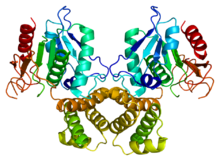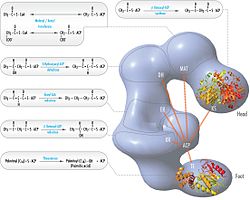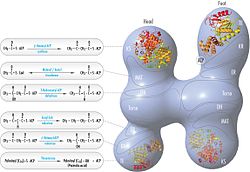Syntáza mastných kyselín
- Nezamieňať s heslom syntéza mastných kyselín.
 Tioesterázová doména ľudskej FAS | |
| Identifikátory | |
|---|---|
| Číslo EC | EC 2.3.1.85 |
| Číslo CAS | 9045-77-6 |
| Databázy | |
| IntEnz | hľadať v IntEnz |
| BRENDA | hľadať v BRENDA |
| ExPASy | hľadať v ExPASy |
| KEGG | hľadať v KEGG |
| MetaCyc | hľadať v MetaCyc |
| PDB štruktúry | RSCB PDB PDBe PDBsum |
Syntáza mastných kyselín alebo syntáza karboxylových kyselín (označovaná ako FAS[1] z anglického fatty acid synthase) je multienzýmový komplex, ktorý sa účastní syntézy mastných kyselín.[2][3] Nejde o jeden enzým, ale o enzýmový komplex zložený z dvoch identických multifunkčných polypeptidových podjednotiek, každej z hmotnosťou 272 kDa, pričom substrát reakcií sa postupne presúva z jednej funkčnej domény k druhej v rámci celého komplexu.[1][4][5][6][7]
Hlavnou funkciou FAS je syntéza mastných kyselín, primárne kyseliny palmitovej (C16:0, nasýtenej mastnej kyseliny s dlhým reťazcom) z acetylkoenzýmu A a malonylkoenzýmu A v prítomnosti NADPH.[8] Syntéza mastných kyselín prebieha pomocou série dekarboxylačných Claisenových kondenzácií. Po každom kole predĺženie reťazca sa beta ketoskupina redukuje na nasýtený uhlíkový reťazec pomocou reakcií katalyzovaných postupne ketoreduktázou (KR), dehydratázou (DH) a enoylreduktázou (ER). Predlžujúci sa reťazec mastnej kyseliny sa medzi týmito aktívnymi miestami presúva tak, že je kovalentne naviazaný na fosfopanteteínovú prostetickú skupinu proteínu ACP (z anglického acyl-carrier-protein, teda proteín prenášajúci acyl), a po tom, čo reťazec dosiahne dĺžku 16 atómov uhlíka (teda vznikne kyselina palmitová) sa uvoľní pôsobením tioesterázy (TE).[1]
U ľudí je tento enzým kódovaný génom FASN.[8][9][10][11]
Triedy
[upraviť | upraviť zdroj]Existujú dve hlavné triedy FAS:
- Typ I – Tieto systémy využívajú jeden veľký multifunkčný polypeptid a sú prítomné u živočíchov i húb (aj keď ich štruktúrne usporiadanie sa medzi živočíchmi a hubami líši). FAS typu I sa takisto nachádzajú u CMN baktérií (rody Corynebacterium, Mycobacterium a Nocardia). U týchto baktérií vytvára FAS I kyselinu palmitovú a potom pomocou systému FAS II produkuje rôzne ďalšie lipidy.[12]
- Typ II – Tento typ FAS sa nachádza u archeónov, baktérií a rastlinných plastidov a je charakterizovaný tým, že využíva oddelené monofunkčné enzýmy na syntézu mastných kyselín. Inhibítory týchto enzýmov (FAS II) sú skúmané ako potenciálne antibiotiká.[13]
Mechanizmy, ktoré využívajú FAS I a FAS II na predlžovanie reťazca a redukciu, sú rovnaké, vzhľadom na to, že domény enzýmov FAS II sú vo veľkej miere homológmi príslušných domén v multienzýmových FAS I. Rozdiel v ich organizácií – teda integrácia do jedného reťazca vo FAS I a oddelené enzýmy vo FAS II – má však za následok mnohé biochemické rozdiely.[14]
Evolučná história FAS je spojená s históriou polyketidsyntáz (PKS). PKS využívajú podobný mechanizmus a homológne domény na tvorbu sekundárnych lipidových metabolitov. PKS takisto existujú v dvoch triedach, podobne ako FAS. Predpokladá sa, že FAS I u živočíchov vznikol modifikáciou PKS I prítomnej u húb, zatiaľ čo FAS I u húb a CMN baktérií vznikol oddelene prostredníctvom spojenia génov FAS II do jedného.[12]
Štruktúra
[upraviť | upraviť zdroj]

Cicavčia FAS je homodimér, ktorý je zložený z dvoch identických podjednotiek. Každá podjednotka sa skladá z troch častí:[15][16]
- N-koniec obsahuje tri katalytické domény:
- ketoacylsyntáza (KS)
- malonyl/acetyltransferáza (MAT)
- dehydatáza (DH)
- centrálna časť sa skladá zo 600 reziduí a umožňuje tvorbu dimérov z dvoch monomérnych jednotiek
- C-koniec obsahuje štyri domény:
- enoylreduktáza (ER)
- ketoacylreduktáza (KR)
- ACP
- tioesteráza (TE)
Klasický model organizácie FAS je z veľkej časti založený na pozorovaniach, v ktorých je bifunkčný reagent 1,3-dibrómpropanón (DBP) schopný prepojiť cysteínové zvyšky v aktívnych miestach KS v jednom monoméri FAS s fosfopanteteínovou prostetickou skupinou ACP domény druhého monoméru.[17][18] Komplementačná analýza dimérov FAS s rôznymi mutáciami na jednotlivých monoméroch ukázala, že KS a MAT domény sú schopné využiť ACP domény oboch monomérov.[19][20] Prepojenie domén pomocou DBP takisto ukázalo, že Cys161 v aktívnom mieste KS sa môže spojiť s ACP 4'-fosfopanteteínovým tiolom oboch monomérov.[21] Okrem toho bolo v roku 2003 ukázané, že heterodimérna FAS obsahujúca len jeden funkčný monomér je takisto schopná syntetizovať palmitát.[22]
Tieto pozorovania sa zdali byť nekompatibilné s klasickým modelom usporiadania FAS, kde by N-koniec a C-koniec smerovali k stredu bielkoviny. Namiesto toho bol navrhnutý nový model, podľa ktorého sa KS a MAT domény oboch monomérov nachádzajú bližšie k stredu diméru FAS, takže „dočiahnu“ na ACP oboch podjednotiek.[23]
Aktuálne je dostupná štruktúra z röntgenovej kryštalografie s nízkym rozlíšením pre FAS z prasaťa (homodimér)[24] a kvasiniek (heterododekamér)[25] a i z kryoelektrónovej mikroskopie (kryo-EM) pre kvasinkovú FAS s rozlíšením ~6 Å.[26]
Mechanizmus prenosu substrátu
[upraviť | upraviť zdroj]Štruktúry kvasinkovej a cicavčej FAS ukazujú dve rôzne organizácie vysoko konzervovaných katalytických domén/enzýmov v rámci tohto multienzýmového komplexu. Kvasinková FAS má veľmi účinnú pevnú štruktúru podobnú sudu so šiestimi reakčnými miestami, ktoré syntetizujú mastné kyseliny nezávisle na sebe. Oproti tomu cicavčia FAS má otvorenú flexibilnú štruktúru, ktorá má len dve reakčné „oblasti“. V oboch prípadoch, u kvasiniek i cicavcov, je však za prenos medziproduktov zodpovedná konzervovaná doména ACP, ktorá je mobilná a presúva substráty medzi rôznymi katalytickými miestami. Prvý priamy pohľad na štruktúru tohto mechanizmu bol získaný pomocou kryo-EM analýzy, pričom ACP bol pozorovaný viazaný na rôzne katalytické domény v sudu podobnej kvasinkovej FAS.[26] Podľa tejto štruktúry z kryo-EM je naviazanie ACP na rôzne miesta asymetrické a stochastické, čo takisto naznačujú počítačové simulácie.[27]
Regulácia
[upraviť | upraviť zdroj]Metabolizmus a homeostáza FAS je regulovaná transkripčne pomocou stimulačných faktorov umiestnených pred génom samotným (Upstream Stimulatory Factors, USF; konkrétne USF1 a USF2) a proteínom SREBP-1c v nadväznosti na príjem potravy alebo inzulín u živých živočíchov.[28][29]
Pečeňové X receptory (LXR) síce modulujú expresiu SREBP-1c pri príjme potravy, ale regulácia FAS pomocou SREBP-1c závisí na USF.[29][30][31][32]
Acylfloroglucinoly (odvodené od floroglucinolu) izolované z paprade Dryopteris crassirhizoma vykazujú inhibíciu FAS.[33]
Klinický význam
[upraviť | upraviť zdroj]Gén FASN bol skúmaný ako potenciálny onkogén.[34] FAS je upregulovaná pri rakovine prsníka a žalúdka a je to i indikátorom zlej prognózy, takže by mohla byť zaujímavým cieľom pre chemoterapeutiká.[35][36][37] FAS inhibítory sú preto aktívnou oblasťou výskumu objavovania liekov.[38][39][40][41][42]
FAS sa takisto potenciálne účastní tvorby endogénnych ligandov pre nukleárny receptor PPARalpha, ktorý je cieľom fibrátových liekov na hyperlipidémiu,[43] a je skúmaná ako potenciálny cieľ pre liečbu metabolickému syndrómu.[44] Orlistat, inhibítor gastrointestinálnej lipázy, inhibuje aj FAS a má potenciál ako liek proti rakovine.[45][46]
U niektorých rakovinových bunkových línií sa našla FAS „zrastená“ s estrogénovým receptorom alfa (ER-alfa), pričom N-koniec FAS sa spojil s C-koncom ER-alfa.[8]
Takisto bol opísaný súvis s leiomyómom maternice.[47]
PDB galéria
[upraviť | upraviť zdroj]-
PDB 1XKT. Tioesterázová (TE) doména ľudskej FAS
-
PDB 2JFD. Štruktúra MAT domény ľudksej FAS
-
PDB 2JFK. Štruktúra MAT domény ľudksej FAS v komplexe s malonyl-CoA
Referencie
[upraviť | upraviť zdroj]- ↑ a b c Animal Fatty Acid Synthase: A Chemical Nanofactory. Chemical Reviews, 2021-08-11, s. 9502–9553. Dostupné online. ISSN 0009-2665. DOI: 10.1021/acs.chemrev.1c00147. PMID 34156235. (po anglicky)
- ↑ ČURDA, Marián; MAŠTEROVÁ, Valéria. Biochémia. 3. doplnené a rozšírené. vyd. Prešov : Rokus publishing, 2020. ISBN 978-80-89510-81-8.
- ↑ ŠKÁRKA, Bohumil; FERENČÍK, Miroslav. Biochémia. 3. vyd. Bratislava : Alfa, 1992. ISBN 80-05-01076-1. S. 233 – 239.
- ↑ Regulation of synthesis of hepatic fatty acid synthetase: binding of fatty acid synthetase antibodies to polysomes. Proceedings of the National Academy of Sciences of the United States of America, October 1975, s. 3956–3960. DOI: 10.1073/pnas.72.10.3956. PMID 1060077.
- ↑ Presence of two polypeptide chains comprising fatty acid synthetase. Proceedings of the National Academy of Sciences of the United States of America, May 1975, s. 1940–1944. DOI: 10.1073/pnas.72.5.1940. PMID 1098047.
- ↑ Specific release of the thioesterase component of the fatty acid synthetase multienzyme complex by limited trypsinization. Proceedings of the National Academy of Sciences of the United States of America, April 1976, s. 1184–1188. DOI: 10.1073/pnas.73.4.1184. PMID 1063400.
- ↑ Structural and functional organization of the animal fatty acid synthase. Progress in Lipid Research, July 2003, s. 289–317. DOI: 10.1016/S0163-7827(02)00067-X. PMID 12689621.
- ↑ a b c Entrez Gene: FASN fatty acid synthase [online]. . Dostupné online.
- ↑ Isolation and chromosomal mapping of genomic clones encoding the human fatty acid synthase gene. Genomics, February 1995, s. 420–424. DOI: 10.1006/geno.1994.1518. PMID 7835891.
- ↑ Human fatty acid synthase: properties and molecular cloning. Proceedings of the National Academy of Sciences of the United States of America, Oct 1995, s. 8695–8699. DOI: 10.1073/pnas.92.19.8695. PMID 7567999.
- ↑ The SDR (short-chain dehydrogenase/reductase and related enzymes) nomenclature initiative. Chemico-Biological Interactions, Feb 2009, s. 94–98. DOI: 10.1016/j.cbi.2008.10.040. PMID 19027726.
- ↑ a b Evolutionary implications of bacterial polyketide synthases. Molecular Biology and Evolution, October 2005, s. 2027–2039. DOI: 10.1093/molbev/msi193. PMID 15958783.
- ↑ Fulmer T. Not so FAS. Science-Business EXchange, March 2009, s. 430. DOI: 10.1038/scibx.2009.430.
- ↑ Fundamentals of enzymology: the cell and molecular biology of catalytic proteins. Oxford [Oxfordshire] : Oxford University Press, 1999. ISBN 978-0-19-850229-6.
- ↑ Human fatty acid synthase: role of interdomain in the formation of catalytically active synthase dimer. Proceedings of the National Academy of Sciences of the United States of America, March 2001, s. 3104–3108. DOI: 10.1073/pnas.051635998. PMID 11248039.
- ↑ Smith S. The animal fatty acid synthase: one gene, one polypeptide, seven enzymes. FASEB Journal, December 1994, s. 1248–1259. DOI: 10.1096/fasebj.8.15.8001737. PMID 8001737.
- ↑ Animal fatty acid synthetase. A novel arrangement of the beta-ketoacyl synthetase sites comprising domains of the two subunits. Journal of Biological Chemistry, May 1981, s. 5128–5133. DOI: 10.1016/S0021-9258(19)69376-2. PMID 6112225.
- ↑ Animal fatty acid synthetase. Identification of the residues comprising the novel arrangement of the beta-ketoacyl synthetase site and their role in its cold inactivation. Journal of Biological Chemistry, March 1982, s. 3230–3235. DOI: 10.1016/S0021-9258(19)81100-6. PMID 7061475.
- ↑ Differential affinity labeling of the two subunits of the homodimeric animal fatty acid synthase allows isolation of heterodimers consisting of subunits that have been independently modified. Journal of Biological Chemistry, February 1998, s. 4937–4943. DOI: 10.1074/jbc.273.9.4937. PMID 9478938.
- ↑ Mapping the functional topology of the animal fatty acid synthase by mutant complementation in vitro. Biochemistry, September 2001, s. 10792–18799. DOI: 10.1021/bi015535z. PMID 11535054.
- ↑ Dibromopropanone cross-linking of the phosphopantetheine and active-site cysteine thiols of the animal fatty acid synthase can occur both inter- and intrasubunit. Reevaluation of the side-by-side, antiparallel subunit model. Journal of Biological Chemistry, April 1999, s. 11557–11563. DOI: 10.1074/jbc.274.17.11557. PMID 10206962.
- ↑ Engineering of an active animal fatty acid synthase dimer with only one competent subunit. Chemistry and Biology, February 2003, s. 169–173. DOI: 10.1016/S1074-5521(03)00023-1. PMID 12618189.
- ↑ Structure and molecular organization of mammalian fatty acid synthase. Nature Structural and Molecular Biology, March 2005, s. 225–232. DOI: 10.1038/nsmb899. PMID 15711565.
- ↑ The crystal structure of a mammalian fatty acid synthase. Science, September 2008, s. 1315–1322. DOI: 10.1126/science.1161269. PMID 18772430.
- ↑ The crystal structure of yeast fatty acid synthase, a cellular machine with eight active sites working together. Cell, April 2007, s. 319–332. DOI: 10.1016/j.cell.2007.03.013. PMID 17448991.
- ↑ a b Direct structural insight into the substrate-shuttling mechanism of yeast fatty acid synthase by electron cryomicroscopy. Proceedings of the National Academy of Sciences of the United States of America, May 2010, s. 9164–9169. DOI: 10.1073/pnas.0913547107. PMID 20231485.
- ↑ Mechanism of substrate shuttling by the acyl-carrier protein within the fatty acid mega-synthase. Journal of the American Chemical Society, September 2010, s. 12357–12364. DOI: 10.1021/ja103354w. PMID 20704262.
- ↑ Hormonal regulation of mouse fatty acid synthase gene transcription in liver. Journal of Biological Chemistry, January 1989, s. 574–577. DOI: 10.1016/S0021-9258(17)31298-X. PMID 2535847.
- ↑ a b Occupancy and function of the -150 sterol regulatory element and -65 E-box in nutritional regulation of the fatty acid synthase gene in living animals. Molecular and Cellular Biology, August 2003, s. 5896–5907. DOI: 10.1128/MCB.23.16.5896-5907.2003. PMID 12897158.
- ↑ Direct interaction between USF and SREBP-1c mediates synergistic activation of the fatty-acid synthase promoter. Journal of Biological Chemistry, February 2007, s. 5453–5467. DOI: 10.1074/jbc.M610566200. PMID 17197698.
- ↑ Identification of liver X receptor-retinoid X receptor as an activator of the sterol regulatory element-binding protein 1c gene promoter. Molecular and Cellular Biology, May 2001, s. 2991–3000. DOI: 10.1128/MCB.21.9.2991-3000.2001. PMID 11287605.
- ↑ Regulation of mouse sterol regulatory element-binding protein-1c gene (SREBP-1c) by oxysterol receptors, LXRalpha and LXRbeta. Genes & Development, November 2000, s. 2819–2830. DOI: 10.1101/gad.844900. PMID 11090130.
- ↑ Fatty acid synthase inhibitory activity of acylphloroglucinols isolated from Dryopteris crassirhizoma. Bioorganic & Medicinal Chemistry Letters, September 2006, s. 4738–4742. DOI: 10.1016/j.bmcl.2006.07.018. PMID 16870425.
- ↑ Fatty acid synthase: a metabolic oncogene in prostate cancer?. Journal of Cellular Biochemistry, January 2004, s. 47–53. DOI: 10.1002/jcb.10708. PMID 14689581.
- ↑ MRNA stability and overexpression of fatty acid synthase in human breast cancer cell lines. Anticancer Research, 2007, s. 27–34. PMID 17352212.
- ↑ Increased expression of fatty acid synthase (OA-519) in ovarian neoplasms predicts shorter survival. Human Pathology, June 1997, s. 686–692. DOI: 10.1016/S0046-8177(97)90177-5. PMID 9191002.
- ↑ Clinical importance of FASN in relation to HIF-1α and SREBP-1c in gastric adenocarcinoma. Life Sciences, May 2019, s. 169–176. Dostupné online. DOI: 10.1016/j.lfs.2019.03.056. PMID 30914315.
- ↑ First Human Study Taking Place With Fatty Acid Synthase Inhibitor [online]. oncotherapynetwork.com, April 7, 2017, [cit. 2023-10-29]. Dostupné online. Archivované 2019-04-15 z originálu.
- ↑ Design and synthesis of a series of bioavailable fatty acid synthase (FASN) KR domain inhibitors for cancer therapy. Bioorganic & Medicinal Chemistry Letters, May 2018, s. 2159–2164. DOI: 10.1016/j.bmcl.2018.05.014. PMID 29779975.
- ↑ A human fatty acid synthase inhibitor binds β-ketoacyl reductase in the keto-substrate site. Nature Chemical Biology, September 2014, s. 774–779. DOI: 10.1038/nchembio.1603. PMID 25086508.
- ↑ Understanding the Intersections between Metabolism and Cancer Biology. Cell, February 2017, s. 657–669. DOI: 10.1016/j.cell.2016.12.039. PMID 28187287.
- ↑ Šablóna:Cite thesis
- ↑ Identification of a physiologically relevant endogenous ligand for PPARalpha in liver.. Cell, August 2009, s. 476–488. DOI: 10.1016/j.cell.2009.05.036. PMID 19646743.
- ↑ Antidiabetic and antisteatotic effects of the selective fatty acid synthase (FAS) inhibitor platensimycin in mouse models of diabetes.. Proceedings of the National Academy of Sciences of the United States of America, March 2011, s. 5378–5383. DOI: 10.1073/pnas.1002588108. PMID 21389266.
- ↑ Fatty acid synthase as a potential therapeutic target in cancer. Future Oncology, April 2010, s. 551–562. DOI: 10.2217/fon.10.11. PMID 20373869.
- ↑ Synthesis of novel beta-lactone inhibitors of fatty acid synthase. Journal of Medicinal Chemistry, September 2008, s. 5285–5296. DOI: 10.1021/jm800321h. PMID 18710210.
- ↑ Genome-wide linkage and association analyses implicate FASN in predisposition to uterine leiomyomata. American Journal of Human Genetics, 2012, s. 621–628. DOI: 10.1016/j.ajhg.2012.08.009. PMID 23040493.
Ďalšia literatúra
[upraviť | upraviť zdroj]- Wakil SJ. Fatty acid synthase, a proficient multifunctional enzyme. Biochemistry, 1989, s. 4523–4530. DOI: 10.1021/bi00437a001. PMID 2669958.
- Fatty acid synthase: a metabolic oncogene in prostate cancer?. Journal of Cellular Biochemistry, 2004, s. 47–53. DOI: 10.1002/jcb.10708. PMID 14689581.
- Lejin D. [Viscosimetry in clinical practice]. Medicinski Pregled, 1978, s. 477–482. PMID 600212.
- Wronkowski Z. [Cancer diagnosis of the respiratory system]. Pielȩgniarka I Połozna, 1976, s. 7–8. PMID 1044453.
- Human fatty acid synthase mRNA: tissue distribution, genetic mapping, and kinetics of decay after glucose deprivation. Journal of Lipid Research, 1995, s. 1507–1521. DOI: 10.1016/S0022-2275(20)39738-8. PMID 7595075.
- Fatty acid synthesis: a potential selective target for antineoplastic therapy. Proceedings of the National Academy of Sciences of the United States of America, 1994, s. 6379–6383. DOI: 10.1073/pnas.91.14.6379. PMID 8022791.
- Human fatty-acid synthase gene. Evidence for the presence of two promoters and their functional interaction. Journal of Biological Chemistry, 1996, s. 13584–13592. DOI: 10.1074/jbc.271.23.13584. PMID 8662758.
- Expression of fatty acid synthase is closely linked to proliferation and stromal decidualization in cycling endometrium. International Journal of Gynecological Pathology, 1997, s. 45–51. DOI: 10.1097/00004347-199701000-00008. PMID 8986532.
- Human fatty acid synthase: assembling recombinant halves of the fatty acid synthase subunit protein reconstitutes enzyme activity. Proceedings of the National Academy of Sciences of the United States of America, 1997, s. 12326–12330. DOI: 10.1073/pnas.94.23.12326. PMID 9356448.
- Fatty acid synthase is expressed mainly in adult hormone-sensitive cells or cells with high lipid metabolism and in proliferating fetal cells. Journal of Histochemistry and Cytochemistry, 2000, s. 613–622. DOI: 10.1177/002215540004800505. PMID 10769045.
- Identification of a novel FAS/ER-alpha fusion transcript expressed in human cancer cells. Biochimica et Biophysica Acta (BBA) - Gene Structure and Expression, 2000, s. 373–377. DOI: 10.1016/s0167-4781(00)00202-5. PMID 11018265.
- FIST/HIPK3: a Fas/FADD-interacting serine/threonine kinase that induces FADD phosphorylation and inhibits fas-mediated Jun NH(2)-terminal kinase activation. Journal of Experimental Medicine, 2000, s. 1165–1174. DOI: 10.1084/jem.192.8.1165. PMID 11034606.
- Human fatty acid synthase: role of interdomain in the formation of catalytically active synthase dimer. Proceedings of the National Academy of Sciences of the United States of America, 2001, s. 3104–3108. DOI: 10.1073/pnas.051635998. PMID 11248039.
- Quaternary structure of human fatty acid synthase by electron cryomicroscopy. Proceedings of the National Academy of Sciences of the United States of America, 2002, s. 138–143. DOI: 10.1073/pnas.012589499. PMID 11756679.
- Direct and indirect mechanisms for regulation of fatty acid synthase gene expression by liver X receptors. Journal of Biological Chemistry, 2002, s. 11019–11025. DOI: 10.1074/jbc.M111041200. PMID 11790787.
- Domain movements in human fatty acid synthase by quantized elastic deformational model. Proceedings of the National Academy of Sciences of the United States of America, 2002, s. 7895–7899. DOI: 10.1073/pnas.112222299. PMID 12060737.
- Polyunsaturated fatty acids decrease the expression of sterol regulatory element-binding protein-1 in CaCo-2 cells: effect on fatty acid synthesis and triacylglycerol transport. Biochemical Journal, 2003, s. 855–864. DOI: 10.1042/BJ20020731. PMID 12213084.
Pozri aj
[upraviť | upraviť zdroj]- Výskum a vývoj inhibítorov gastrointestinálnej lipázy
- Syntéza mastných kyselín
- Metabolizmus mastných kyselín
- Rozklad mastných kyselín
- Enyol-ACP reduktáza
- Zoznam porúch metabolizmu mastných kyselín
Zdroj
[upraviť | upraviť zdroj]Tento článok je čiastočný alebo úplný preklad článku Fatty acid synthase na anglickej Wikipédii.



